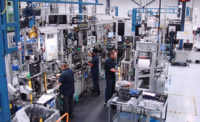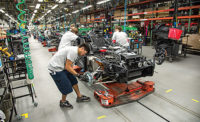The Assembly Plant of the Year Award was created in 2004 to showcase world-class production facilities in America, and the people, products and processes that make them successful.
Here’s a brief look at the diverse facilities that have received the award. Unless otherwise noted, data related to plant size, performance metrics, production equipment, number of employees and type of product assembled pertains to the year the award was received.
Some plants now produce entirely different products. A good example is Ford Motor Co.’s Michigan Assembly Plant. When it received the award back in 2012, it was making small cars, such as the Ford Focus. Today, the facility mass-produces sport utility vehicles and pickup trucks. In 2020, Ford invested $750 million to retool the plant to assemble the newly relaunched Bronco SUV alongside the Ranger pickup.
Click here to nominate a facility for the 2024 Assembly Plant of the Year award (the deadline is May 1).
Renton, WA
Product: Heavy-duty trucks
Plant size: 270,000 square feet
Employees: 1,400
Year opened: 1993

Employees at the Polaris Industries Inc. motorcycle factory in Spirit Lake, IA, celebrate the 2015 Assembly Plant of the Year award. Photo by Austin Weber
The Renton plant was nominated for its innovative use of information technology to reduce production costs, increase productivity, improve safety, shorten time to market, and enhance product quality and yields. The company also developed and implemented a variety of high-tech tools on its plant floor to build products faster, better and more efficiently than its competition.
Kenworth, a division of PACCAR Inc., views itself not as a truck company that uses technology, but rather as a high-technology company that builds trucks. The Renton plant has aggressively applied information technology to improve the way it assembles custom-engineered, build-to-order trucks, including both on- and off-highway models.
For example, engineers developed a cab harness electrical tester that is connected to the cab electrical system while the cab is still on the trim line. This allows workers to do a functional test of all gauges, switches and lights to ensure the cab is ready for setting onto the chassis.
Webster, NY
Product: Digital production presses
Plant size: 635,000 square feet
Employees: 1,300
Year opened: 1960
The Webster plant was nominated for its innovative use of Lean Six Sigma processes. Xerox transformed its assembly process from traditional methods to a more specialized, technically advanced approach. From 2003 to 2005, the facility achieved a $97 million year over year product cost productivity improvement through labor and overhead optimization, in addition to direct materials cost reduction through supplier negotiations, resourcing and redesign.
The plant is customer-focused and delivers world-class products across five continents, while continuously evolving to remain competitive. To produce full-color printers, operators install 100 motors, 70 printed circuit boards, 27 power supplies and 3.5 miles of wiring into every machine that they build. Although it weighs almost 8,000 pounds, the iGen3 is built to tolerances smaller than a human hair. Each digital production press takes 9 days to build and test.
Montgomery, AL
Product: Automotive seating
Plant size: 84,000 square feet
Employees: 408
Year opened: 2004
The Montgomery plant assembles more than 300,000 sets of seats annually for the nearby Hyundai factory. By applying Six Sigma and lean manufacturing—as well as state-of-the-art production equipment—the facility builds seats just a few hours before they are inserted into vehicles.
Teams of employees manage their own budgets, attendance, job assignments, housekeeping and performance discipline. That innovative approach to labor relations helps the plant achieve impressive results, such as 1 percent absenteeism, zero plant-controllable ergonomic issues, and high levels of measurable safety, quality, delivery, cost, process and environmental standards.
Every team member is certified to perform each of the assigned team operations. Every hour, they rotate jobs. The advantages of this approach are increased ownership, morale and accountability.
To improve productivity and reduce defects, operators use DC electric tools and radio frequency identification technology. That allows Lear to achieve impressive delivery and quality statistics, without sacrificing safety. At the same time, there have been zero plant-controllable ergonomic issues.
Lexington, KY
Product: Residential load centers
Plant size: 480,000 square feet
Employees: 2,500
Year opened: 1957
The Lexington plant features state-of-the-art production equipment, such as smart parts bins, torque monitoring systems and robotic palletizers. But, when it comes to manufacturing philosophy, the plant is old school. Vertical integration is alive and well. Injection molding, metal stamping, plating, painting and packaging is all done in-house. Being vertically integrated helps keep manufacturing lead times and costs low.
Combined with lean manufacturing initiatives, the unique approach is paying off. The plant achieved 20 percent growth in volume between 2002 and 2006. It also experienced a 6.7 percent annual improvement in labor productivity. That has allowed the facility to stay competitive and keep manufacturing close to its customers.
Poughkeepsie, NY
Product: High-end servers and data centers
Plant size: 315,000 square feet
Employees: 6,000
Year opened: 1941
IBM’s environmental commitment is showcased at its flagship Poughkeepsie assembly plant. The facility, situated on a wooded 500-acre campus along the banks of the Hudson River north of New York City, is committed to the environment through a Green Sigma initiative. The goal is to save money, boost productivity and reduce the environmental impact of IBM’s end-to-end supply chain operations by minimizing waste and emissions, while more efficiently managing energy, materials and natural resources. Disassembly and remanufacturing are a regular part of day-to-day operations. From 2004 to 2008, the plant reused more than 11 million parts. More than 1,450 high-end computers have been recovered, refurbished and reused, while more than 25,000 metric tons of metal have been recycled.
The plant is implementing a major recycling initiative and conducting a full waste audit that encompasses materials such as bubble wrap, electrostatic discharge bags, foam inserts and shrink wrap, in addition to traditional forms of paper and plastic.
Manchester, TN
Product: Metal caskets
Plant size: 450,000 square feet
Employees: 370
Year opened: 1970
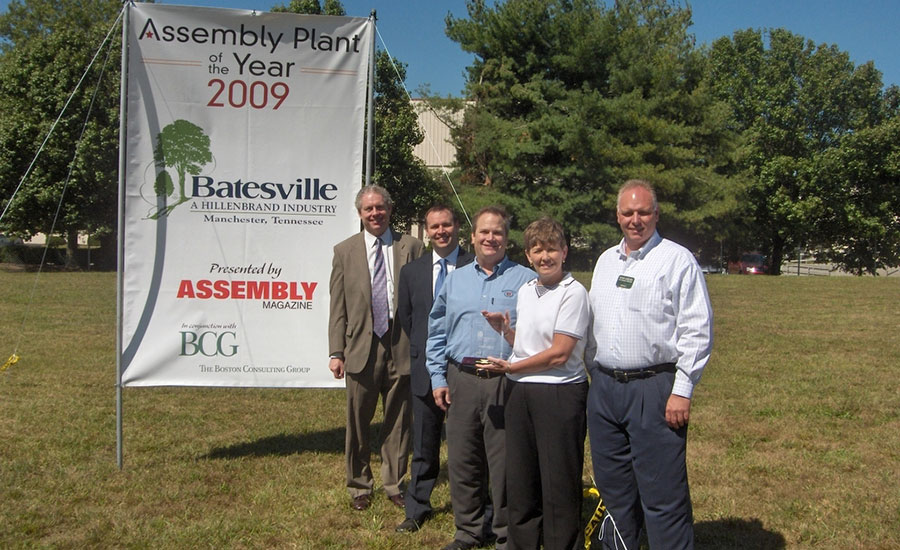
Batesville Casket Co’s facility in Manchester, TN, received the 2009 Assembly Plant of the Year Award. Photo courtesy Batesville Casket Co.
Assemblers in Manchester mass-produce steel caskets with an endless variety of options and features. In fact, more than 70 percent of the products built at the facility are personalized and built to order. By implementing lean manufacturing initiatives, the facility streamlined its operations.
Assemblers use continuous improvement activities and lean tools to identify and eliminate waste. Since the plant went lean, cost per unit dropped 24.3 percent and floor space was reduced by more than 50 percent. From 2007 to 2009, the factory reduced its costs by 3 percent above inflation.
The plant is also impressive because it’s a vertically integrated operation that produces 98 percent of the 224 parts needed to assemble a typical casket. All metal stamping, plastic injection molding, fabrication and painting is done in-house. In addition, Batesville Manchester operates an in-house fabric shop where employees cut, stitch and staple all the material to line the interior of caskets. Even metal bed frames, pillows and cushions are made in-house.
Lincoln, IL
Product: Load centers and electric meters
Plant size: 380,000 square feet
Employees: 436
Year opened: 1958
This facility located along Route 66 opened the same year that the first issue of ASSEMBLY magazine rolled off the printing press. This high-mix, high-volume plant has multiple assembly lines that produce a wide variety of different models. The company launched more than 1,000 new products from 2008 to 2010. The plant’s in-house engineering team designed those products for cost-efficient assembly and customer value.
The Lincoln leadership team devised a manufacturing vision called Project Runway to ensure the plant’s long-term success. The goal was to increase capacity each year, achieve 30 percent growth, drive cost out and improve flexibility without adding floor space. A slogan, “Protecting our Future in the Heartland,” was chosen to energize the workforce as change occurred.
During a two-year period, the plant achieved more than $15 million in savings, much of it due to lean manufacturing initiatives and investments in new production technology. Sales per employee improved by 20 percent. The facility reduced the cycle time for four product family value streams by more than 40 percent.
New Kensington, PA
Product: Electromechanical medical devices
Plant size: 172,000 square feet
Employees: 200
Year opened: 2009
This state-of-the-art facility was designed from the ground up with three things in mind: people, lean manufacturing and the environment. Efficient manufacturing systems are hallmarks of the operation, including raw material kanban, dock-to-stock material receipts, single-piece flow, digital work instructions, automation, world-class IT systems, flexible work teams, highly engaged employees, self-directed continuous improvement and mixed-model assembly lines. Since the plant opened, assembly errors decreased more than 80 percent, while labor efficiency improved by more than 35 percent.
A stunning, two-story atrium located near the entrance of the factory resembles something found in a health club. Visitors encounter a vast floor-to-ceiling window that overlooks the heart of the plant, which features an attractive blue production floor. The large window enables people to see the look and feel of the factory as soon as they walk into the building.
Wayne, MI
Product: Small passenger cars
Plant size: 5 million square feet
Employees: 5,170
Year opened: 1957
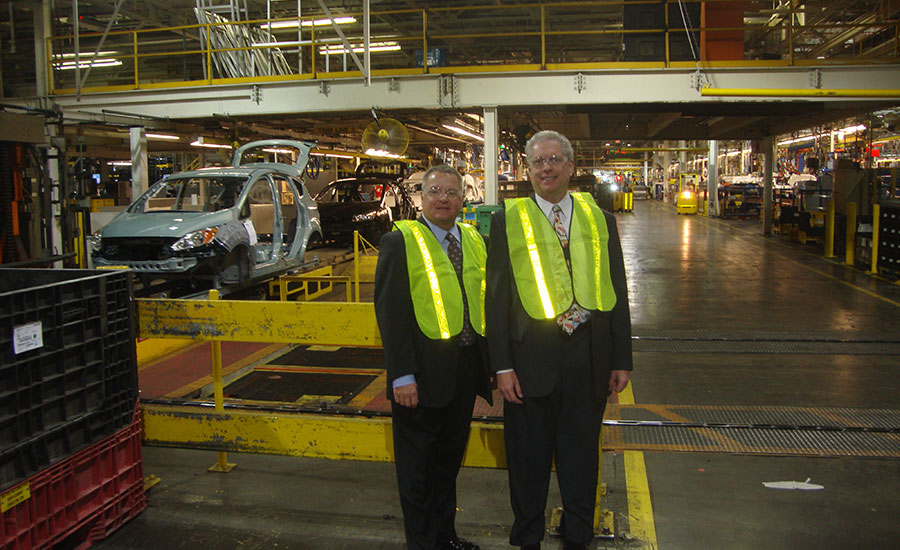
ASSEMBLY publisher Bill DeYoe and senior editor Austin Weber tour Ford Motor Co.’s Michigan Assembly Plant in Wayne, MI, in 2012. Photo courtesy Ford Motor Co.
Ford engineers transformed an old plant that once made the Edsel into a state-of-the-art factory that assembles fuel-efficient small cars. The company invested $550 million to make the complex the first assembly plant in the world capable of building a full line-up of vehicles on the same line.
Thanks to an integrated production strategy, assemblers build three different types of electrified vehicles alongside traditional gas-powered cars. New tools and equipment, coupled with world-class quality standards and a revised lean production philosophy, allow Ford to make small cars profitably while adjusting production volume and production mix based on market demand.
Operators at the flexible facility must contend with an extra layer of complexity, including electric motors, electric inverters and converters, high-voltage batteries, charge ports, electronic control units and other components that are not found in conventional vehicles.
The trim and chassis lines contain 792 assembly information system boxes that help eliminate misbuilds and mistakes caused by human error. The mistake-proofing devices ensure build quality as well as build integrity.
The trim and chassis lines are equipped with more than 500 electric nutrunners capable of precisely measuring torque. An angle-sensing function detects incorrectly tightened joints. The tools are also attached to electronic controllers that calculate and monitor torque using a calibrated transducer. The DC-electric fastening tools provide accurate feedback and ensure full torque capability at each fastener.
Palmdale, CA
Product: Fighter jet fuselages
Plant size: 3.2 million square feet
Employees: 2,500
Year opened: 1953
Secretive Plant 42 is a government-owned facility in the Mojave Desert operated by Northrop Grumman Aerospace Systems. It’s a world-class operation that provides assembly, integration, testing and long-term maintenance capabilities for some of the world’s most advanced military aircraft.
The new Integrated Assembly Line (IAL) represents a significant shift in how airframes are assembled, enabling the defense contractor to achieve a 450 percent increase in throughput, while increasing the program’s affordability, quality and efficiency. Inspired by automation systems used by American automakers, the robotic assembly line produces the center fuselage of the F-35 Lightning II fighter jet.
The IAL maximizes robotics and automation, providing additional capacity and assembly capability, while meeting engineering tolerances that are not easily achieved using manual methods. It uses a system-engineering approach to integrate tooling and structure transport, system automation, automated drilling cells, and tooling mechanization coordinated across multiple build centers.
Virginia Beach, VA
Product: Chainsaws and outdoor power equipment
Plant size: 2.1 million square feet
Employees: 1,765
Year opened: 1974
This state-of-the-art factory features seven chain saw assembly lines and 15 power tool assembly lines. The vertically integrated facility ensures on-time delivery of high-quality products through the innovative use of automation, people and flexible production processes that reduce cost and increase value.
The factory manufactures important parts in-house to guarantee quality and meet delivery deadlines. It makes its own engines and major components, including crankshafts, manifolds and pistons. A large plastic injection-molding operation produces more than 100 million plastic parts a year, such as covers, fuel tanks, handles, shrouds and triggers. Vibration and infrared welding equipment is used to assemble motor housings and other plastic components.
In addition to in-house machining and molding operations, STIHL produces associated accessories, such as the guide bars used in chain saws and the nylon line used in trimmers. The company’s 60,000-square-foot guide bar plant is the most advanced facility of its type in the world. All stamping, welding, riveting, painting and packaging processes are fully automated from start to finish.
STIHL’s vertically integrated philosophy carries over to in-house machine building and systems integration. Advantages of in-house machine building and systems integration include reduced cost, internal knowledge base, standardization and reduced machine production launch time.
Spirit Lake, IA
Product: Motorcycles
Plant size: 390,000 square feet
Employees: 1,000
Year opened: 1994
This world-class plant has combined flexible production processes and lean manufacturing principles to successfully launch an aggressive lineup of new products, including an electric motorcycle. The facility embraces cutting-edge production technology, such as automated guided carts, cordless screwdrivers and DC electric fastening tools. It recently installed a state-of-the-art paint shop that will allow the facility to triple production capacity.
Polaris engineers created a flexible and scalable manufacturing process to quickly react to any new product introductions, as well as to provide the flexibility for adjusting production volume and production mix. The facility can build low-volume, factory-custom bikes on the same line as high-volume models. Engineers tackled the challenge by carefully aligning automation, systems, tools, process flows and material deliveries to boost productivity, improve quality and increase throughput.
The plant switched from air tools to cordless tools for most fastening applications other than safety-critical joints, which use DC electric tools. Older J-hook overhead chain conveyors have also been replaced with automated guided carts.
Fountain Inn, SC
Product: Hydraulic motors and pumps
Plant size: 500,000 square feet
Employees: 700
Year opened: 1989
Flexible production processes and lean manufacturing principles ensure on-time delivery. The majority of products produced at the high-mix, low-volume facility are built-to-order. The 100-acre manufacturing campus is vertically integrated and consists of three buildings that house nine assembly line, eight test stands and two machine shops. During the last four years, assembly lines have been radically altered to respond to rapidly changing market dynamics. The plant embraces cutting-edge production technology, such as cordless screwdrivers, DC electric fastening tools and paperless work instructions.
Quick changeover plays a key role in the plant’s success. Capacity issues can be addressed through overtime and weekend shifts as necessary. The specific assembly process is optimized for each value stream based on the design of the product.
An assembly sequencing program improved quality by guiding assemblers through the production process. It prevents an operator from starting a new operation at the beginning of the line until a certain operation at the end of the line is complete. This dropped detected assembly errors from about 15,000 parts per million per day to 0.
The facility includes an apprentice shop where young trainees can acquire the hands-on skills needed to operate the company’s production systems. Apprentices work at the factory and also attend classes at a local technical college to gain advanced manufacturing skills. During their two-year tenure, students are on a six-month rotation. During this time, they are exposed to nonmachining related topics, such as assembly, test, quality inspection, tool management and tool setting, as well as some logistical functions.
Jackson, MN
Product: Farm tractors and spraying equipment
Plant size: 1,033,000 square feet
Employees: 900
Year opened: 1965
Innovation is everywhere in this facility, which produces tractors (both wheeled and tracked) and sprayers on mixed-model assembly lines. During the past five years, AGCO has invested more than $50 million in the factory to increase production capacity and efficiency. The plant embraces plant floor innovations ranging from automated guided carts to cordless screwdrivers.
One of the newest initiatives involves using wearable “informed reality” technology on the plant floor to reduce errors, address quality and boost productivity. Employees are using lightweight, optical, head-mounted displays to work more productively. More than 100 pairs of Google Glass are being worn by employees for quality inspections and assembly work.
The ability to have access to work instructions in quality, assembly and paint prep has led to reduced processing times, reduced defects and reduced training costs. AGCO has seen over a 30 percent reduction in inspection times, a 25 percent reduction in production time and the ability to train staff 300 percent faster.
Sterling Heights, MI
Product: Automatic transmissions
Plant size: 2.2 million square feet
Employees: 1,550
Year opened: 1968
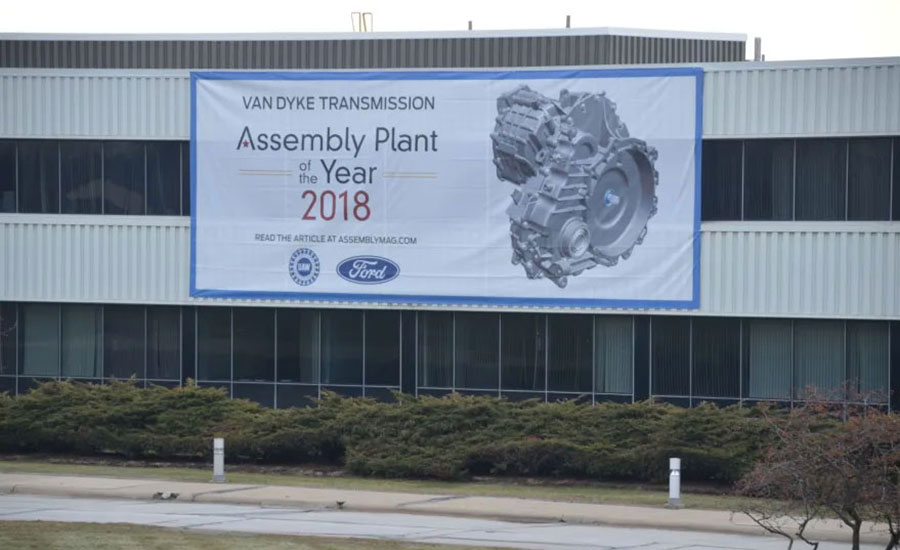
Ford Motor Co.’s Van Dyke transmission plant hung a large banner on the front of the facility in 2018 to celebrate being the Assembly Plant of the Year. Photo courtesy Ford Motor Co.
This high-mix, high-volume plant supplies 67 different transmission models to 24 North American assembly plants and 13 overseas facilities. The factory applies sophisticated technology for press-fit assembly, fastening and dispensing. Vision-guided robots are used throughout the facility for material handling and assembly. Automatic-learning technology has been applied to some robots to improve robustness and accommodate part variation.
The Van Dyke plant uses automation to streamline production processes and address quality or ergonomic issues. It has deployed more than 80 robots and more than 500 inline machine vision applications that address error proofing, gauging and complexity issues.
For instance, robots and vision systems are used to dispense sealant. A six-axis robot applies a bead of room-temperature vulcanizing silicone at variable quantities, speeds and angles. The application is validated with a vision inspection system that ensures the correct path and width of the bead.
One of the newest robotic applications at Ford Van Dyke is located in a clean room that assembles sensitive components. The automated station features two high-speed delta robots that each insert seven tiny retention pins in a valve body subassembly that controls shifting.
The engineering and production teams use standardized process reviews to monitor throughput and adjust constraint management issues that arise during daily production. High-mix complexity is managed by optimizing transmission model batch sizes to minimize changeover frequency.
Data analytics is an important part of that process. The plant carefully monitors both real-time and historical data. Real-time data is used to address concerns immediately. Historical data is used to determine trends or reoccurring concerns.
Decatur, AL
Product: Refrigerators
Plant size: 2 million square feet
Employees: 1,043
Year opened: 1977
The Decatur facility assembles more than 5,000 refrigerators a day—in multiple sizes and configurations—while meeting key performance indicators, such as cost, delivery, employee engagement, quality and safety. Its products are consistently rated No. 1 in dependability and quality by consumers. The plant is a leader in applying data analytics, lean manufacturing and vertical integration.
The vertically integrated facility produces many parts in-house to guarantee quality and meet delivery deadlines. For instance, the plant operates a large plastic injection-molding operation and a copper tube bending department. Key components, such as evaporators, are also made in-house.
The plant has invested in state-of-the-art automation, such as robotics and automated guided vehicles, to address issues related to ergonomics and material handling. It recently deployed AGVs to transport refrigerator doors through fabrication, foaming and assembly.
Campbellsville, KY
Product: Automotive exterior mirrors
Plant size: 200,000 square feet
Employees: 340
Year opened: 2000
This world-class plant produces more than 2 million side-view mirror assemblies annually. It ensures timely delivery of complex products through the innovative use of automation, people, continuous improvement and flexible production processes. Thanks to recent improvements in automation, throughput increased by 34 percent from 2018 to 2020. To increase productivity, the factory has invested in state-of-the-art production technologies, including additive manufacturing, automated guided vehicles, automated screwdriving systems, error-proofing systems, karakuri racking, paperless work instructions, robots and vision systems.
The plant also underwent a major cultural shift that dramatically improved operations. It relied heavily on team building to achieve a successful turnaround, which involved bridging two unique continuous improvement cultures. The management team put a lot of energy and effort into making process improvements to increase throughput. As a result, productivity has improved while various performance metrics, such and downtime and scrap rate, have greatly declined.
Newton, NC
Product: Automotive all-wheel drive systems
Plant size: 505,000 square feet
Employees: 1,200
Year opened: 1985
The Newton plant supplies all-wheel drive systems to BMW, Ford, General Motors and Stellantis. The facility features multiple assembly lines that mass-produce more than 1.5 million units annually. GKN has successfully applied automation, continuous improvement, flexible production processes and quality controls. New technologies, an aggressive overhaul of existing processes, and a change in plant floor culture have led to many accomplishments. Among other achievements, the plant has reduced scrap by 80 percent.
Error-proofing efforts in the plant have been upgraded and now include non-quality critical operations as well to ensure that even minor maintenance-related issues are addressed quickly. GKN Newton’s newest assembly line features robots that automatically error-proof the process every few cycles.
Vision systems have also helped the plant reduce errors and improve quality. Cameras are primarily used to detect external components such as circlips and O-rings.
Vance, AL
Product:Automotive door modules and seat structures
Plant size:302,000 square feet
Employees:792
Year opened: 2004
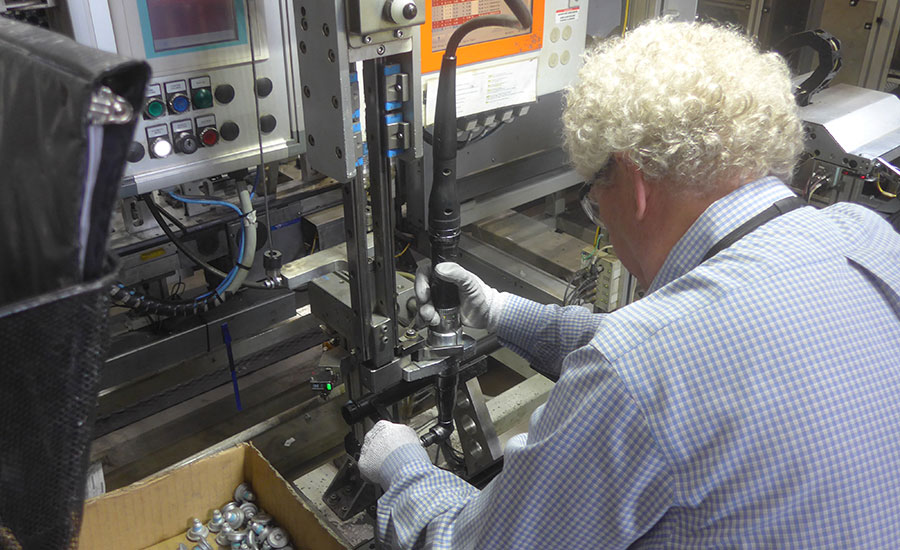
ASSEMBLY senior editor Austin Weber tries out a fastening tool on the assembly line at Brose Tuscaloosa in Vance, AL, in 2022. Photo courtesy Brose Tuscaloosa Inc.
The Vance plant supplies door modules and seat structures to BMW, Ford, Mercedes-Benz, Volvo and Volkswagen. The facility features 12 final assembly lines supported by state-of-the-art laser welding, riveting and screwdriving operations. Brose has implemented a variety of innovative process and quality control systems. In addition, the company excels at employee engagement and fostering a culture that inspires continuous improvement. Among other achievements, the plant has improved productivity and production costs by 25 percent over the last four years.
Brose Tuscaloosa has conducted numerous process improvements and implemented procedures to reduce cost and improve quality. Production costs have improved by 25 percent over the last four years and productivity has improved by 14 percent, resulting in an average continuous improvement savings of more than $2 million annually.
In addition, the facility is a leader in applying continuous improvement and quality initiatives. To improve efficiency and quality, the plant recently invested in direct-weld measurement technology for seat structure production. The in-line weld monitoring system increases manufacturing efficiency, streamlines validation and minimizes waste.
The plant also prides itself on fostering a culture that engages people, inspires continuous improvement initiatives, and makes the facility a fun, safe place to work. Employee engagement programs include transparent communication and weekly podcasts.
A unique management build initiative is a regular event where all levels of leadership roll up their sleeves and participate in various assembly tasks. They spend one hour every month working on the factory floor. It provides a great opportunity for employees to exchange ideas and suggestions.
Managers and operators identify improvements needed, such as workstation layout, ergonomics, safety issues and material flow. This regular interaction provides team members with a comfortable setting to discuss and present their ideas for improvement.
El Cajon, CA
Product: Acoustic guitars
Plant size: 178,000 square feet
Employees: 700
Year opened: 1992
Taylor Guitars prides itself on innovation and playing its own tune when it comes to automation, green manufacturing, process controls and vertical integration. The company blends modern, innovative manufacturing techniques with a master craftsman’s attention to detail. That’s why it uses in-house developed automation, including robotics and machine vision technology to improve productivity, address ergonomic issues and boost quality. In addition, Taylor is a leader in sustainability. It uses a variety of wood that is ethically sourced from around the world.
The company has pioneered new guitar designs and construction techniques at its El Cajon factory. And, it’s been out in front when it comes to developing and adopting production technology.
The employee-owned company employs some of the best luthiers in the world who are skilled at crafting fine wood instruments. But, Taylor doesn’t shy away from automation. It uses SCARA and six-axis robots for adhesive dispensing, buffing, finishing and electronics assembly applications.
In addition, the company is a leader in sustainability. Taylor Guitars doesn’t just talk about ecology, recycling and sustainability. It lives and breathes it as part of the company’s DNA. The factory uses a variety of wood that is ethically sourced from around the world. Recent initiatives have also focused on responsible stewardship of natural resources by planting trees and upcycling.


